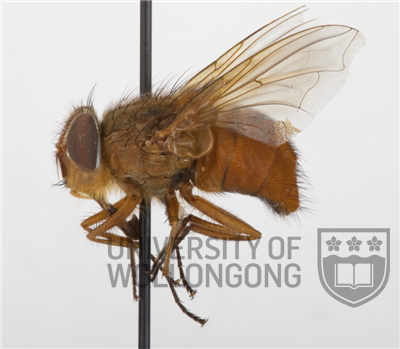Taxonomy
Family: Calliphoridae
Subfamily: Calliphorinae
Genus: Calliphora Robineau-Desvoidy 1830
Subgenus: Neocalliphora Brauer & Bergenstamm 1891
Species: ochracea Schiner 1868
The third-instar larva was described by Erzinçlioglu (1984).
Biology
Calliphora ochracea is the sister species of Calliphora nigrithorax. The larvae of this species have been reared by Fuller (1931) and the present authors in whole-animal carrion and sheep's liver. We have also reared it from a human corpse in the wet sclerophyll forest of the Dandenong Ranges, Victoria. Palmer (1980) confirmed the carrion-breeding behaviour of this species in the field by observing C. ochracea larvae in sheep and rabbit carcasses.
This species can be distinguished mainly by its light mesonotum (C. nigrithorax has a darcker mesonotum, with a blackish appearance). These two species are probably similar to the ancestor of modern day Calliphora species (Kurahashi 1971). The dense yellow hairs on the eye facets, large thoracic spiracles and unicolourous abdomen are probable characteristics shared by C. ochracea and C. nigrithorax and the ancestral species (Wallman 1993). Male C. ochracea can be readily distinguished by the minimum frons width being less than the width of the anterior ocellus, whereas in male C. nigrithorax the minimum frons width is greater than the width of the anterior ocellus. See the similar example of Calliphora albifrontalis and Calliphora stygia in the picture. Male frons width in C. ochracea is similar to C. stygia, whereas frons width of C. albifrontalis is similar to C. nigrithorax.
Distribution
Calliphora ochracea occurs in coastal areas, but appears in greatest abundance in high-elevation forested country. Although it is reported as uncommon, it can be highly abundant in localities where conditions are favourable (Fuller 1931). Specimens have been identified from the Australian Capital Territory, New South Wales, Queensland and Victoria. It appears to be most common in the winter months (pers. obs.).
Relevant Literature
Erzinçlioglu, Y.Z. (1984) Studies on the
morphology and taxonomy of the immature stages of
Calliphoridae, with analysis of phylogenetic
relationships within the family, and between it and
other groups in the Cyclorrhapha (Diptera). Ph.D.,
University of Durham.
Fuller, M.E. (1931)
The life history of Calliphora
ochracea Schiner (Diptera, Calliphoridae). Proceedings of the
Linnaean Society of New South Wales 56, 172-181.
Palmer, D.H. (1980) Partitioning of the carrion resource by sympatric Calliphoridae (Diptera) near Melbourne. Ph. D., La Trobe University.




